A look at Wild Is the Wind, the film and its theme song.
In July 1968, just before I turned thirteen, Phil Ochs released his fifth LP, Tape from California. I didn’t know Ochs from Adam, and because one of our local FM stations played only the album’s title track in fairly heavy rotation, I didn’t know it contained his rendition of “Joe Hill” as well as the self-penned “White Boots Marching in a Yellow Land.” Also unknown to me were his “The War Is Over,” which preceded John and Yoko’s billboard campaign by about eighteen months, and his famous anthem “I Ain’t Marching Anymore” from three years prior. I only heard those when seeing him live during a concert on April 11, 1969 at CU’s Macky Auditorium.
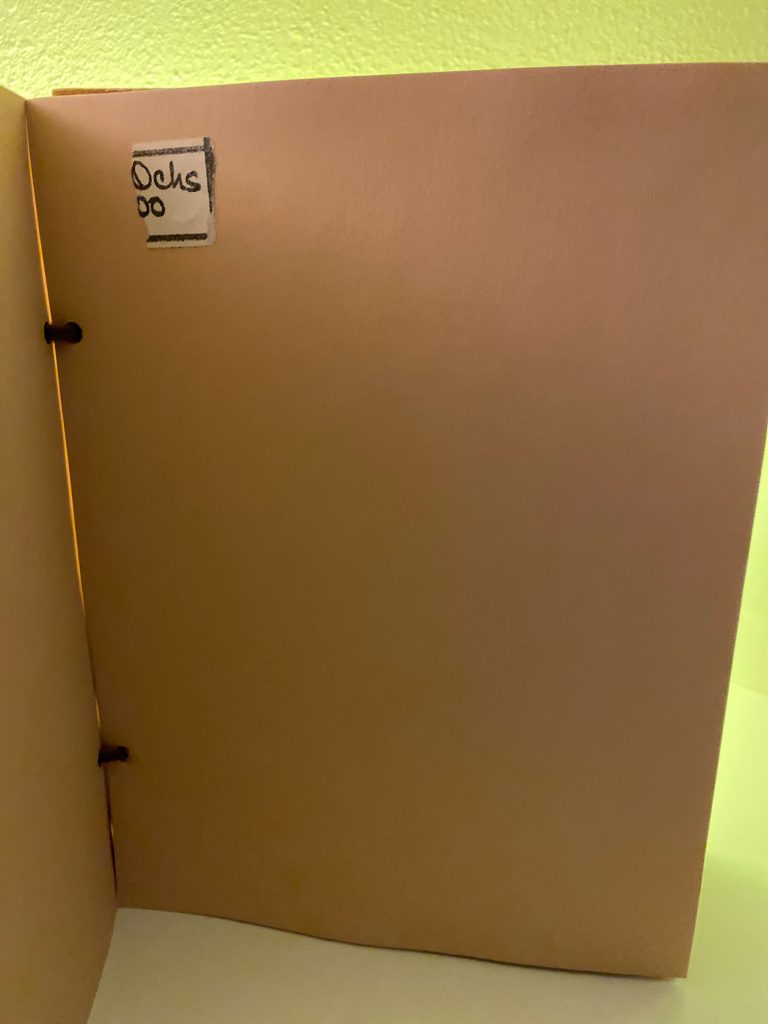
Clueless, in the fall of ’68 I had voted for Nixon in a junior high school mock election. My shocked schoolmate Marjorie took me under her wing in due course, while Phil Ochs had yet to contribute to the soundtrack of my conversion. Clueless, that summer upon first listen, I’d thought Ochs was Johnny Mathis, so untrained was my choirboy’s ear. Ten years ago I tried to convince my late comrade Lowell May of the two singers’ resemblance, pairing Ochs’s title song along with Mathis’s rendition of “Light My Fire,” released four months later. Lowell: “I still don’t hear the similarity between the singers, but I can better see how you might.” Ouch.
Clueless, I found out only recently that Johnny Mathis—not Nina Simone—had first recorded “Wild Is the Wind.” The song supports the opening credits of George Cukor’s 1957 film by the same name. Perhaps some day I’ll get through the thing. It appears to be a tragedy, with tragic inevitability, but that doesn’t quell my dread as Anthony Quinn’s character resuscitates his late wife in the person of her sister, played by Anna Magnani. She is no zombie but rather a she-wolf, “La Lupa” being the title of the 1874 short story by Giovanni Verga from which Wind was adapted—once removed. Verga’s tale had been the loose basis for Furia (Fury), directed in 1947 by Magnani’s then-estranged husband Goffredo Alessandrini.2
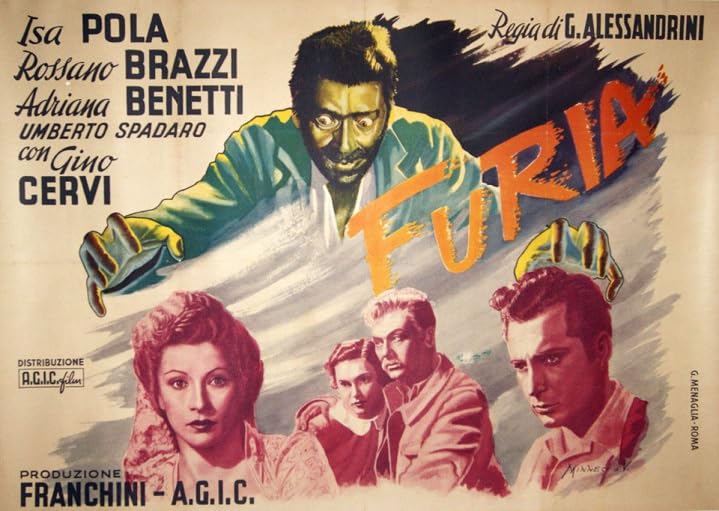
A translation of Verga’s very short story by D. H. Lawrence is terse and in line with the Italian author’s non-magic realist verismo, which he and others developed as a sort of home-grown naturalism (cf. Émile Zola and Guy de Maupassant).3 That a five-page narrative could spawn three and a half hours of film is remarkable.4
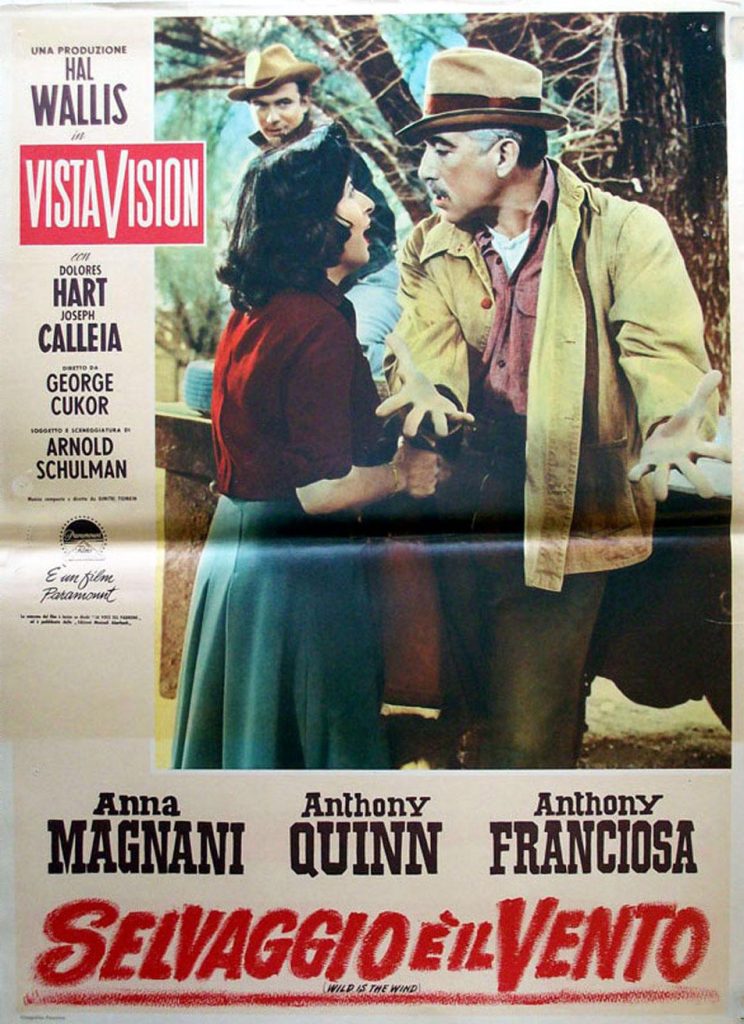
Both Verga (rod in Italian, in case you were wondering) and director Alessandrini aligned themselves with nationalist movements, with the latter having directed fascist propaganda films in the ’30s (according to Italian Wikipedia) and an anti-communist/anti-fascist Ayn Rand adaptation in 1942 (according to English Wikipedia). Meanwhile, of course, Hollywood was churning out pro-Soviet product like 1943’s Mission to Moscow, which three years later was pounced on by the House Un-American Activities Committee.
William Haynes biographer William Mann writes that, in World War II:
[Wind director] George Cukor held out while older colleagues like Frank Capra and John Ford quickly enlisted. Finally Cukor joined up [in the fall of 1942], serving as a private in the Signal Corps.5
Cukor made instructional films while Clare Booth Luce’s The Women, the play he’d adapted for the screen in ’39, was, mm…, mounted in all-male USO-style productions to entertain the troops, by the troops.6 A by-then ubiquitous Carmen Miranda drag number is included in Moss Hart’s 1943 play Winged Victory, which Cukor in turn would film the next year for Twentieth Century-Fox and the Army. Thus the Greatest Generation led to the Great Pansyfication, which in the Twenty-first Century is being addressed by retrograde forces obsessed with dresses.
“Wind” co-composer Dmitri Tiomkin, born in what now is Ukraine, also contributed to the war effort. He penned scores not for the sort of Department of War films that Cukor would be directing, but rather for the aforementioned Italian-born Frank Capra, whose seven-title series Why We Fight had been inspired personally by a belated viewing of Leni Riefenstahl’s Triumph of the Will (1935). Tiomkin described “Wind” lyricist Ned Washington: “Debonair, sophisticated, he cuts a dapper figure with his hair-line black mustache.” And he “excels in popular pathos.”7
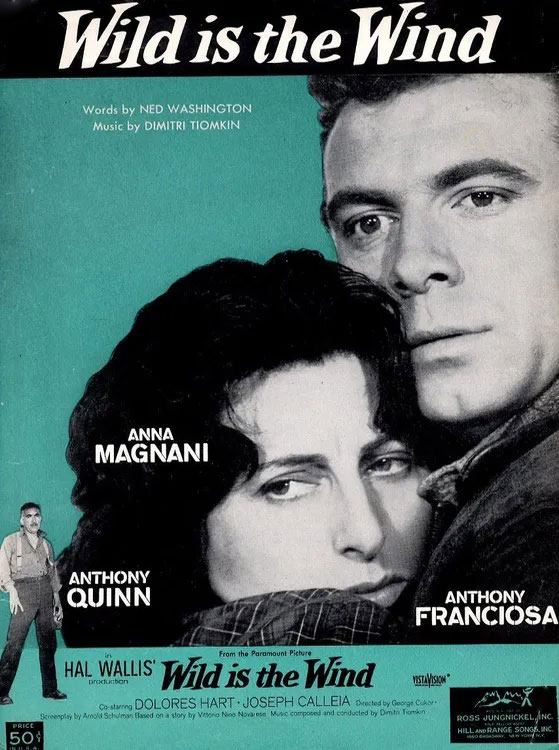
In his autobiography, Wind producer Hal Wallis wrote in compelling detail about the production, including of Anna Magnani and Tony Franciosa’s parallel affair, but mentions nothing about the film’s theme song.8 Ditto in biographies of George Cukor. If, say, a PhD candidate has written about the song’s background, I’d be interested to read it.
Johnny Mathis
“Wild Is the Wind,” the song, begins with Ray Ellis and Orchestra’s stringy strings and alto ostinato prior to Mathis’s audacious yet understated, “Love me, love me”—only two—“say you do.”
Constrained by the film credits’ 2:26 envelope, Washington wastes no time: “Let me fly away with you.” He published his first poetry at age twelve,10 and so: “Give me more than one caress;/ Satisfy this hungriness” (which, it turns out, is not a neologism). Mathis, at twenty-one, rises to the occasion with, “You touch me,” and then, deliciously understated once more, “You kiss me.” He plays but a bit with the pace, a foretaste of how Nina Simone and David Bowie would have their way with it. All appetitive ardor subsides, however, as Mathis ends on a C#5, singing, with nary a breeze, “Wild is my love for you.”
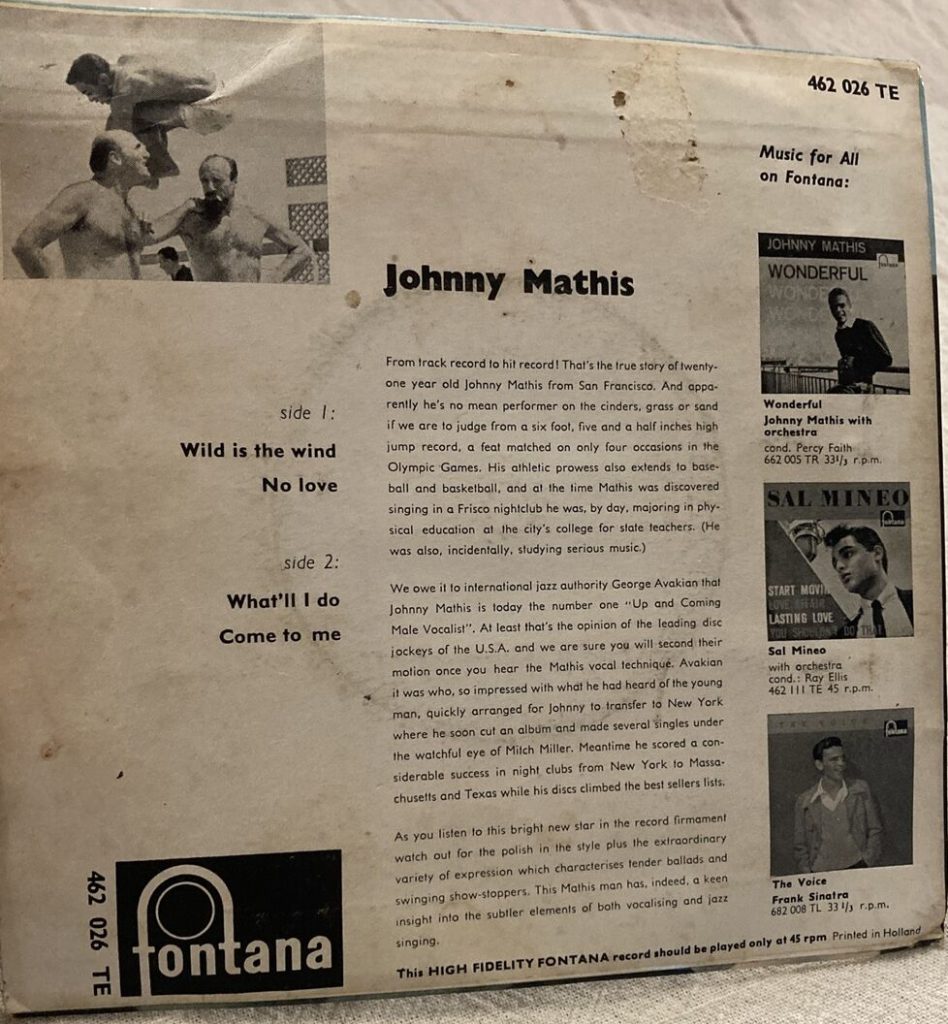
Nina Simone
Two years after Mathis, Nina Simone included the song in her first live collection, recorded at New York’s Town Hall on September 12, 1959. Except that “Wind,” while wild, wasn’t live. That track and two others out of the eleven issued had been recorded in an unknown studio the next month for a December drop. In the LP’s Wikipedia entry Simone’s biographers could only infer as to this discrepancy: according to Nadine Cohodas and Alan Light, Simone was paired with her bassist and drummer at Town Hall without a meeting, let alone a rehearsal. To compensate she might have dragged out these songs’ intros to allow the seasoned sidemen to lock in, intros that could have been too lengthy for LP. “Wild Is the Wind” clocks in at 3:22 on this record.
David Bowie
Simone rethought the song in the ’60s and released a new studio version (above), at nearly seven minutes. This likely is the version that moved David Bowie to cover it in 1975 after he met Simone that year in Los Angeles, “although rumours of a studio collaboration remain[ed] only rumours.”11 While taping the song’s album, Station to Station, at Cherokee Studios in Hollywood, Bowie met Frank Sinatra, who was looking for rooms to record in after retiring from retirement. Cherokee co-owner Bruce Robb said the two became pals, with Sinatra giving the cover song the green light. Bowie biographer Marc Spitz:
Based on Sinatra’s enthusiasm for the track, Bowie was inspired to include what might have seemed an odd choice (a middle-of-the-road ballad sung unironically amid mutant Euro-funk and lyrics about blow and the occult) as the record’s closing track.”12
In a troubling clip from Nina, documenting Simone’s 1976 appearance at Montreux a few months after Station to Station’s release, she calls out for Bowie, “my dear friend,” who she says, “lives with you,” but “he’s not here, obviously; he’s still driving from some damn place.” Alas, by the time I saw Bowie during his Serious Moonlight tour at the Inglewood Forum in August 1983, he had dropped “Wild Is the Wind” from his set.
The Good, the Bad, and the Ugly
“Wild Is the Wind” has been covered by many artists. The sampling below demonstrates both a fidelity to previous versions as well as some envelope pushing. See also a list from SecondHandSongs of about 150 versions, both vocal and instrumental, many with links to audio.
- Bat for Lashes (string arrangement released for International Record Day, 2010)
- Clan of Xymox (goth, 1993; “yeah”)
- The Hempolics (reggae, 2019)
- George Michael (pop, 1999)
- Billy MacKenzie (acoustic, 2001)
- Helmut Zacharias (violinist, instrumental, 1958)
- Dee Alexander (jazz, 2008)
- Anna Kolchina (jazz, 2017)
- Ahmad Jamal (jazz chorus, 1968)
- Barbra Streisand (pop, 2003; she hears “the sound of violins”)
- Caroline Henderson (jazz funk, 2006)
- Larry Adler (jazz harmonica, 1958; no audio)
- Joe and Eddie (gospel folk, 1964)
- Larry Young (jazz organ, 1967; Athea Young vocal)
- Joe Bonner (jazz piano, instrumental, 1983); Joe Bonner Trio (jazz, piano instrumental, 1979, rel. 1987)
- Randy Crawford (jazz, 2000)
- Stephanie Rogers (pop, 2022)
- Joanne Shaw Taylor (rock, Bowie’s arrangement, 2016)
- Chrissie Hynde with the Valve Bone Woe Ensemble (jazz, 2019)
Notes
- See “Phil Ochs Tonight in Macky” display ad, Colorado Daily, 11 Apr 1969, 9.
- Cinephile Dan Callahan writes that the sobriquet “La Lupa” was given to Magnani herself.
- See Martin Greenberg, “Giovanni Verga’s verismo,” The New Criterion, May 2004, archived here.
- Lawrence’s translation of “La Lupa” appears in Randall Jarrell (ed.), The Anchor Book of Stories, New York: Doubleday, 1958, 41–46.
- William J. Mann, Wisecracker: The Life and Times of William Haines, Hollywood’s First Openly Gay Star, New York: Penguin, 1999, 309, 308.
- Allan Bérubé, Coming Out Under Fire: The History of Gay Men and Women in World War Two, New York: Free Press, 1990, 88. Also William J. Mann, Behind the Screen: How Gays and Lesbians Shaped Hollywood 1910–1969, New York: Viking, 2001, 241.
- Dimitri Tiomkin, Please Don’t Hate Me! (1959), in Mervyn Cooke, ed., The Hollywood Film Reader, New York: Oxford University Press, 2010, 133.
- Hal Wallis and Charles Higham, Starmaker: The Autobiography of Hal Willis, New York: Macmillan, 1980, 131–135.
- See the Companies, etc. section of this Discogs entry, crediting Jon Mat as the producer.
- Louis Calta, “Ned Washington, Lyricist, Dead,” New York Times, 22 Dec 1976, 32.
- Nicholas Pegg, The Complete David Bowie, Richmond, Surrey: Reynolds & Hearn, 2002, 205. Pegg’s Bowie bio was published the year before Simone’s death, and so the “rumours […] remain only rumours.”
- Marc Spitz, David Bowie: A Biography, London: Clipper Large Print, 2011, 454.


Fascinating history to this tune. I just assumed Bowie had written it back when I bought the album. Obviously, did not bother to read the liner notes. Nina Simone’s piano is the stand out. And who arranged Bowie’s version? Eno?
Rob, that’s a good question. Eno wasn’t involved in Station to Station; that began with Low (1977). The album was co-produced by Bowie and Harry Maslin (Manilow’s “Mandy,” Bowie’s “Fame” and “Golden Years”). Bowie Biographer Marc Spitz claims the “template” for “Wild Is the Wind,” “Aladdin Sane,” and “Life on Mars?” is the song “Inchworm,” originally from the Danny Kaye vehicle Hans Christian Andersen (1952), the chords of which Bowie pursued as a teen. “You wouldn’t believe the amount of my songs that have sort of spun off that one song,” he told Spitz. (Spitz, 29–32) Whether this can be detected in “Wind” is beside the point; it indicates that Spitz felt that Bowie was hands-on in the song’s arrangement.
Hi David, just got to reading this one. I learned during the early days of the pandemic that Bowie covered this original of Nina Simone. It’s one of my absolute Bowie favorites, so I was blown away. I always assumed Bowie wrote it. I really enjoy reading your blogs when I get around to it.
Thanks, Valerie.